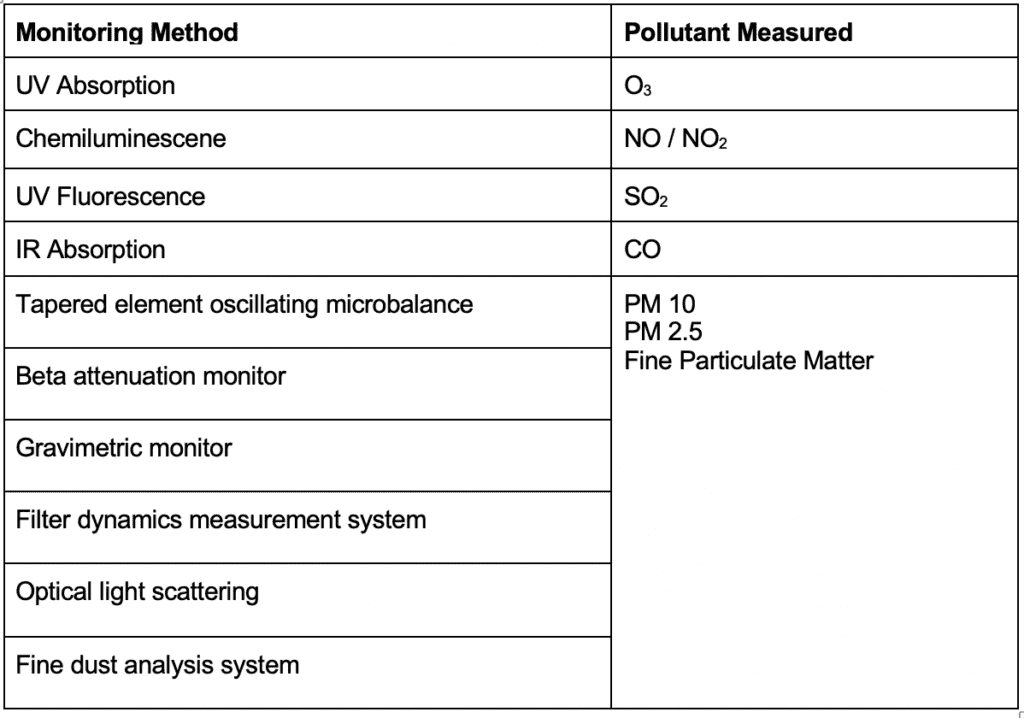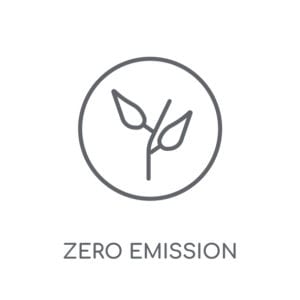More information on Air Quality and Testing >
Air quality is a term used as a measure of the condition of air, relative to any need or purpose, and how clean or polluted the air may be in any given environment. There are serious health issues and environmental concerns when air quality is poor with hazardous pollutants and fine particulate matter. Air quality monitoring and testing is an essential part of industry and environmental agencies’ responsibilities to create safe workplaces, clean urban spaces, and overall healthy environments on a national scale.
Clean and healthy air is a necessity for all of us in work, home, and overall life. Laws, regulations and directives are in place to help air monitoring across all environments and within cities with high traffic volume. Measurements, monitoring, and testing are in place to collect data and analyse pollution level and air quality. However, pollutant control cannot be substituted by exposure monitoring – pollution level data can fluctuate daily.
Air quality testing instruments and air quality analysis techniques test for specific particulates and pollutant concentration from various sources in the atmosphere. This also includes a precautionary measure for employee exposure to vapour, fume, gas, or dust at work, as well as the general population in any given environment. Source testing and air quality analysers can either be a fixed system for long term measurements or, as technology has developed, a small personal monitor to measure an exact area – remote air quality testing is now possible in the harshest conditions and environments.

Equipment and systems have moved on in terms of accuracy, size, power, and build quality. As science develops, we have a better understanding and a greater opportunity to create healthier and cleaner environments locally, nationally and globally.
The first stage to testing and improving air quality comes in identification. By identifying and recognising pollutants in the air and where they are coming from, we can then move forward in reducing particulate matter in both natural and built environments. After initial identification, monitoring goals can be defined, established, and implemented.
Characterising an air pollution problem allows for the understanding of variations within pollution concentrations. Hotspots within cities can be detected, ambient sources recognised, and a comprehensive assessment of health and environmental impacts carried out.
Once identification and monitoring have begun, then public and governmental awareness can be raised for improvements to be executed. The data collected in air quality monitoring can affect policies, urban planning, industrial management, among other public-health interventions and targeted incentives in emission-reducing projects.
Urban spaces with transport links and dense populations are one of the main hotspots for air pollution. Projects like Breathe London Project aim to implement hundreds of monitor systems and sensors across London to combat toxic pollutants across the city. Hospitals, schools, and businesses will be able to access real-time data on the air quality around them, which will, in turn, lead to education for wider communities and the next generation on how we can improve the environment around us.

Road traffic within built-up areas is the main contributor to smog and carbon monoxide pollution. Emissions from vehicles have a major effect on climate change and increase greenhouse gases across the globe.
Recognising and monitoring the hotspots and sources of air pollution in urban settings allows for research and development into more renewable and sustainable modes of transport to progress. For example, cities can consider introducing better public transport links to reduce road traffic that is also better for the environment, like hydrogen-powered technology, which will have a significant impact on improving air quality.
Industry, factories, and power plants are notorious air pollution hotspots. Identifying what pollutants are being mixed into the atmosphere will help business revise their processes and improve the overall performance in relation to creating a cleaner environment and safer workplaces.
The impact on harmful air quality from industrial emissions not only contributes to greenhouse gases and climate change, but these toxic pollutants can enter the soil, affecting the crops grown and agricultural trade.
Testing air pollution levels in this context is a crucial part of monitoring stations. It allows for information to be gained that can map out future developments for sustainable manufacturing and energy sources across the world.
The same particulate matter and pollutant gases can be found in both indoor and outdoor environments. There are similar health effects of air pollutants, regardless of the setting, if the air quality is poor.
Climate change is the biggest environmental crisis of our time, with air quality at the forefront of the threat. Mankind contributes ten times more carbon into the atmosphere than the natural cycle of volcanoes, along with other greenhouse gases increasing exponentially.
The increase of greenhouse gases in the atmosphere leads to adverse weather conditions, rising sea levels and temperatures, causing the natural ecological cycle of the world to be thrown off balance.
Science in air quality, with precise measurements and monitoring of air pollution levels, can assist industries and governmental bodies to change the direction of climate change and global warming. Collecting data and real-time information resource is a major stage to help science improve the state of global environments.
Implementing a network of sensors and air quality monitors, paired with data analysis, can lead to new pathways for scientists to advise sectors on how to improve air quality and reverse damaging effects on the environment.
Each monitoring system and design requires choosing what particulate matter (PM) and gases to detect and analyse, depending on the source of concern. There are various air pollutants that sensors monitor in UK air quality, all are harmful towards both humans and the environment.
NOx refers to the nitrogen oxides that are most prevalent in air pollution from traffic emissions and combustion of fuels – nitric oxide (NO) and nitrogen dioxide (NO2) being the most notable. These harmful gases cause smog and acid rain, as well as having damaging effects on the ozone layer in the atmosphere.
Along with respiratory health concerns, NOx gas emissions intensify global warming with the increase of greenhouse gases to the atmosphere and interference with tropospheric ozone levels.
Carbon monoxide is an odourless gas that is extremely toxic when exposed to high levels and has detrimental effects on the environment. This gas is commonly found in excess within urban settings due to the high concentration of traffic and fuel combustion, and also within homes from heaters, gas ovens, and other appliances. Real-time sensors and monitoring systems are essential to ensure air quality is safe.
The average home has 0.5-5 ppmv (parts per million by volume), while cities with high traffic volumes can exceed 200 ppmv. Vehicle emissions are a contributing factor to rising carbon monoxide levels in the environment across the world.
Carbon dioxide is an essential component of the natural world. However, the excessive levels of CO2 in the atmosphere has negative effects and the environment can’t keep up the natural cycles. Deforestation and burning fossil fuels have increased the amount of CO2 in the atmosphere, throwing the environment off balance.
The climate effect of carbon dioxide levels increasing is significant, as is the health concerns and acid rain falling across the globe. Innovative and sustainable methods can be used in place of the current source of carbon dioxide emissions which will help move forward to future goals.
Particulate matter (PM) is the term used to describe liquid droplets and solid particles found in air, such as smoke, dust, and dirt. Sometimes PM can be big enough to see with the naked eye, unlike the gases previously mentioned. These can be a combination of both organic and inorganic matter.
Particle size can vary and is often categorised into two types: PM 10 and PM 2.5.
These microscopic particles of dust and dirt in the air are a direct release of particles from vehicles, fuel, and agricultural emissions, as well as condensation and evaporation often found in coastal regions.
The instruments used to measure levels of particulate matter in the air use gravimetric methods and weigh out the components found in the samples tested.
Along with the pollutants already mentioned, sensors and detecting technologies also test for these gases and PM to determine the AQI (Air Quality Index):
Air quality monitoring methods and techniques are always being developed and improved. There is an assortment of methods in use across the UK and Europe to assess air quality and collect valuable data:

Diffusion tubes are a low-cost, highly accessible piece of equipment that is easy to deploy across large geographical areas and provide time-integrated measurements. Diffusion tubes and samplers are used to indicate and monitor NO2 (nitrogen dioxide) and are particularly useful:
Diffusion tubes are most commonly used in traffic emission monitoring.
Spectroscopic techniques are top of the range offering high accuracy with time-resolved reference instruments. These techniques and tools use light to probe the sample to determine the consistency of matter. Observations on the radiation and wavelengths from particulate matter provide critical information on air quality.
Various projects, like the Horizon 2020 Research Project, use sensor technology to improve air quality in cities across Europe and urban areas to track emissions and pollutant gases. As testing equipment evolves, air quality data can become more accurate and comprehensive.
Laboratory work is an essential part of air quality testing. This step determines what pollutants are present in the samples and the levels of concentration. Testing laboratories test both indoor and outdoor air quality using the air quality monitoring methods previously described.
Environmental testing laboratories allow the collected data to be scientifically backed up with full details of pollutant concentrations. This information aids policymakers and allows for a progression of control measures on emissions and the like.
| The Automatic Urban and Rural Network is a comprehensive monitoring system across the UK to ensure compliance with Ambient Air Quality Directives. These stations monitor a whole range of pollutants: ● oxides of nitrogen (NOx) ● sulphur dioxide (SO2) ● ozone (O3) ● carbon monoxide (CO) ● particles (PM 10, PM 2.5) Along with these pollutants, these monitoring stations across the UK also collect information on weather patterns, rainfall, temperatures, wind speed and direction, humidity, and barometric pressure. From this compiled data, long-term trends can be determined, predictions forecasted, and assessment carried out on the effectiveness of pollution controls in place. Similar studies and monitoring programmes are in place internationally and in specific locations of significant climate concerns. |

Laws and regulations are in place to provide measures and guidelines for air quality control. Health concerns and environmental threats are a priority of these directives. The World Health Organisation report 4.2 million deaths per year globally due to ambient pollutant exposure. In the UK alone, 40,000 deaths per year are attributed to air pollution levels in the environment according to studies carried out by the Royal College of Physicians.
WHO’s air quality guidelines are a significant contributor to governmental natural risk management and environmental policies, in the aim to protect public health and the environment. Through this, there are coordination efforts at national, regional, and local levels in the attempt to control pollutant sources and monitor levels of emissions.
The European Commission has implemented these directives to set air quality standards and requirements to improve European air quality:
So where does Brexit leave the UK air quality control measures and the British environment?
Currently, “the government has promised to uphold environmental laws now that the UK has left the EU.” However, there are several requirements that the UK Government will need to adhere in order to back up this claim and protect both our environment and UK air quality.
One of the most important treaties for the environment across the world is The Paris Agreement. This is a legally binding international agreement to combat climate change that brings together the most powerful and influential countries across the globe. The Paris Agreement treaty aims to lower the temperatures in global warming by tackling greenhouse gas emissions.
Countries across the world are working together to improve overall air quality and the climate, supporting the cause in:
By 2024, all monitoring and tracking information will be reported by the various nations on an ETF system, enhanced transparency framework. This information resource and statistics from global monitoring stations will be a major helping fact in combating the environmental crisis and poor air quality.

The ultimate goal of The Paris Agreement is to reach a global carbon emission level of net-zero by 2050. This will be achieved by developing cleaner industries, using sustainable fuel sources, and improving overall air quality in the reduction of greenhouse gas emissions.
The Air Quality Index is a scale used to measure the level of air pollution and provide relevant health and safety guidance. The index is a range from 1 to 10 and separated into 4 bands, 1 being the lowest risk and 10 being the most severe air pollution.
The DEFRA Air Quality Index is a nationwide recognised scale that workplace and environmental air quality monitoring systems use to provide public health information. There are similar scales used internationally. The bands are as follows;
Polluted air has a significant effect on the body as well as the natural environment. The toxic gases can cause long-term health conditions when exposed to high concentrates. Air pollution effects can be as follows, but are not limited to:
| Pollutant | Health Effect |
| Nitrogen Dioxide, Sulphur Dioxide, Ozone | Irritation of airways and lungs, symptoms of lung diseases and respiratory illness. |
| Particle Matter | Carried and lodged deep into the lungs causing serve respiratory illness and lung diseases. |
| Carbon Monoxide | Prevents blood uptake of oxygen, lead to a significant reduction of oxygen levels and cause heart disease-related illnesses. |
An air quality monitor is a specialised piece of equipment to measure the levels of air pollutants in any given environment. These sensors can be used in both indoor and outdoor settings. Ambient air quality monitors are a key part of assessing pollution levels across the country, providing real-time data daily as it fluctuates.
Source monitoring within air pollution hotspots is needed to ensure air quality is safe for living spaces and detect areas where improvements can be made to reduce greenhouse gases and emissions. Air quality monitoring and gas analysis are important for social science and ecological science to provide clean air space in varying environments.
Three key areas of air pollution are industrial, domestic, and traffic emissions. These harmful pollutants can be hard-to-detect gases such as carbon monoxide and ozone, as well as fine particulate matter that can be seen easily like soot, dirt, and smog. Deforestation is a major contributing issue to air pollution and poor air quality.
Photochemical and optical sensor systems use UV light and infrared absorption to identify and measure gases and components in samples of air. The techniques can vary from a simple diffusion tube to the more advanced spectroscopic equipment, both providing real-time information.
With modern advances in technology, air quality testing monitors and sensors can be compact and portable. This allows for more local and individual tests to be performed in a variety of environments. Handheld air quality monitors are being used in several urban projects to propel information resource and data.
More information on Air Quality and Testing >
